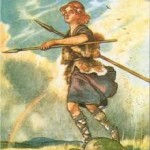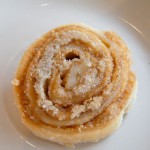Informant: “I heard an Irish legend, it was the story of a guy named Cú Chulainn. He wasn’t originally called Cú Chulainn because Cú means dog. But, he was the most fearsome warrior in all the land. But I am getting ahead of myself; sorry I am a horrible story teller. Ok so, he grew up as a farm boy and there was an elite group of warriors and he ran all the way across Ireland to try out for them and he blew everybody out of the water and he was this super feared warrior and whatnot and people would just surrender if they knew he was coming. But he was invited to a party for one of the lords and his military general or whatever was there and asked him to grab somebody so he left on a quest, and when he came back the lord had the most feared dogs in the land and the dogs attacked him and he killed the dogs, but they were these prized dogs. So, in order to make amends for him killing his hosts dogs, he told him I’ll be your dog, and so he was the lords dog in the sense that he would stand out and guard the place and that’s how he became called Cú Chulainn.”
The informant comes from a very small town in California. The informant states that “there is nothing to do there, it is just a small town and the biggest thing we have is a Walmart.” The informant first heard this tale when she went to Ireland on a school trip last spring break and it was told to her by one of the people she met in her group. This other member told the informant many different stories, but she remembers this one “because I had the song on my Ipod and they were telling the story of it” and she was very excited that she had heard a reference to the tale before.
The song “Blood of Cú Chulainn” was used as the theme of a movie known as “The Boondock Saints” (1999) by Troy Duffy. A picture of the movie is attached. http://www.youtube.com/watch?v=l1IVZpk_rVo is a link to the song.
After looking up Cú Chulainn, I found that his name was originally Sentanta, and there are many stories and legends associated with this epic Irish hero that extend far beyond how he received his name. Cú Chulainn is part of a series of legends and stories that span his life, somewhat similar to Greek heroes like Achilles. He noted in Irish mythical sagas for his superhuman strength and amazing deeds on the battlefield. From what I could find, his story was originally passed down by word of mouth, until it was written down more than 800 years ago in the Táin Bó Cúailnge.
In fact, the story is so popular that it was drafted into a five, short animated, bilingual series on BBC (and thus a folk-loreisthmus): http://www.bbc.co.uk/northernireland/schools/4_11/cuchulainn/. This series follows the hero and tells the tales of some of his deeds as he grows up. Apparently, this tale is used in Irish schools to teach language and literacy.
This BBC series tells a variant of the naming of Cú Chulainn which states:
“Setanta is invited with his friends to a great feast but he starts to daydream and is left behind. By the time he arrives the feast has begun, the gates are locked and worse, the guard dog attacks him. Setanta kills the dog by driving a hurley ball (sliotar) down its throat. The host, Culann, the blacksmith is furious at the loss of the fiercest dog in Ireland. Setanta offers his services as replacement and is duly renamed, Cú Chulainn, Culann’s Hound.”
Another longer variant of this story states that:
“While at home with his parents at Murtheimne Plain, the five-year-old Setanta heard exciting rumours about a school in Armagh called the Macra. It was run by the King Conchobhar of Armagh to train the best young boys of the day to be great warriors for Ulster, called the Red Branch Knights. Setanta made a big impression at the Macra. One day in particular, he was down at the playing field, playing a game called Shoot-the-Goal against 150 of his classmates. All 150 of them together couldn’t stop any of his shots into the goal with his sliotar, nor could they score a goal against him.
The king was going to a special feast that night, organised for only the most important warriors in Ulster by the blacksmith Culann. On his way, he passed the field and watched the boys playing. He was so impressed with Setanta’s domination of the other boys that he decided to invite him to the feast too. But Setanta was completely caught up in the game and replied, ‘I haven’t had my fill of play yet, friend Conchobhar. I’ll follow you on.’ The king agreed and went on his way. When the king arrived at the feast, the host welcomed him and asked whether there was anyone to come after him. King Conchobhar forgot that he had invited Setanta and replied that there was no one else. So Culann released his savage hound to guard the premises from attackers while the guests feasted. This was no ordinary dog. Three chains were needed to hold it, with three men on each chain.
Soon Setanta arrived, playing with his hurley and sliotar as he travelled. On seeing him, the hound ran out with his ferocious teeth shining in the dark. At this stage, the men feasting could hear what was happening, but they could only watch from the door because the dog was too fast to stop. They were sure this was the end for Setanta. However, in a flash, Setanta raised his hurley and thwacked his sliotar with great force at the dog. His aim was perfect, as the ball ripped into its mouth and through its body, killing it instantly. Culann was relieved that Setanta had survived the encounter, but sad to have lost such a great guard dog. To make up for killing him, young Setanta promised to guard Culann’s land until a new puppy had been reared. Impressed with this promise, those at the feast agreed that Setanta should be given a new name. They called him Cúchulainn, which means ‘the Hound of Culan’. Still only a young boy, Setanta was known by this name from then onwards. Cúchulainn had numerous adventures after that. He became the best Red Branch Knight and did King Conchobhar proud.”
( For more information visit this website: http://www.askaboutireland.ie/learning-zone/primary-students/looking-at-places/louth/cuchulainn/setanta/)
Although the informant says that she is not experienced story teller and thus would be considered a passive folklore bearer. It is interesting to see what parts of the tale she remembers and why she remembers it, especially the version that she gives in relation to the versions that can be found online because this tale is widely drafted and has many different variations. This story and the one that the informant told share many similarities; although, the informant’s story is not set when Cú Chulainn is a young man, but after he has already received much recognition and no mention is made regarding the duration Cú Chulainn is to serve the lord. In addition, the informant includes more than one dog, although the other versions have only one.
The Boondock Saints. Dir. Troy Duffy. Perf. Willem Dafoe, Sean Patrick Flanery, and Norman Reedus. Franchise Pictures, Brood Syndicate, Fried Films, 1999. Film.
Cú Chulainn. BBC. November 2012. Television.






